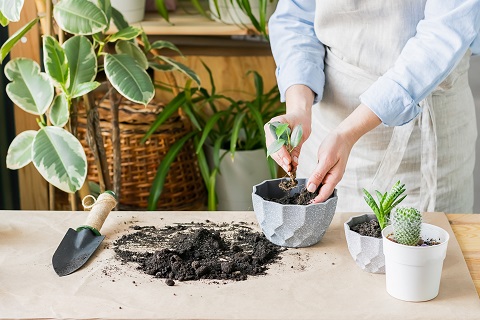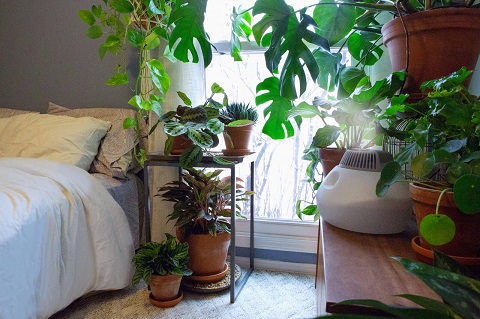.jpg)
Introduction
Caring for houseplants can bring a lot of charm and beauty to your home. Imagine a peaceful abode filled with lush greenery. However, it is important to understand that each plant has unique needs and needs proper care to thrive. Unfortunately, many people make mistakes when it comes to houseplant care, resulting in issues such as yellowing of leaves, stunted growth, even death of plants etc. in order to avoid them. By following these guidelines, you can create an environment that will enhance your indoor garden and enjoy the fruits of healthy, vibrant plants.
Section 1: Improper Watering Techniques

One of the most common mistakes in houseplant care is improper watering. Each plant has specific watering requirements, and understanding these needs is crucial for their well-being. Overwatering is a prevalent issue that can lead to root rot, fungus gnats, and ultimately, the decline of your plants. On the other hand, underwatering can cause dehydration and stunted growth. To avoid these problems, follow these essential watering tips:
- Understand Your Plant's Watering Needs: Different plants have different watering preferences.
- Water the Soil, Not the Leaves: When watering your plants, focus on the soil rather than the leaves.
- Avoid Water Accumulation: Discard any accumulated water in the saucer after watering.
Section 2: Choosing the Right Pots and Soil

The selection of pots and soil is another critical aspect of houseplant care. Choosing the wrong type of pot or using improper soil can hinder your plant's growth and overall health. Here's what you need to know:
Pot Selection and Drainage
Using pots without drainage holes is a common mistake that can lead to waterlogged soil and root rot. Drainage holes allow excess water to escape, preventing the roots from sitting in a saturated environment. When selecting pots, opt for those with drainage holes to ensure proper water management.
Soil Composition
Choosing the right soil is equally important. Most houseplants thrive in well-draining soil that allows air circulation around the roots. Consider using a high-quality potting mix that is specifically formulated for indoor plants. These mixes often contain a combination of organic matter, such as peat moss or coconut coir, and materials that promote drainage, like perlite or vermiculite.
Section 3: Providing Adequate Sunlight

Proper sunlight exposure is vital for the growth and vitality of houseplants. However, different plants have varying light requirements. Understanding your plants' sunlight needs will help you provide the ideal conditions. Here's what you should know:
Assessing Light Levels
Before placing your plants, assess the light levels in different areas of your home. Some plants thrive in bright, direct sunlight, while others prefer indirect or low light conditions. Observe the intensity and duration of sunlight in each location to determine the best spot for your plants.
Sunlight Requirements for Different Plants
Research the specific light requirements of your plants. For example, succulents and cacti generally thrive in bright, direct sunlight, while ferns and snake plants prefer shade or indirect light. Match each plant to an appropriate location based on their specific sunlight needs.
Protecting Plants from Harsh Sunlight

Direct sunlight, especially during the hottest parts of the day, can scorch and damage certain plants. If placing your plants in a sunlit area, consider using sheer curtains, blinds, or moving them a few inches away from the window to provide partial shade and protect them from intense sunlight.
Section 4: Maintaining Optimal Temperature and Humidity
Proper temperature and humidity play significant roles in the health and well-being of houseplants. Extreme temperatures and low humidity can cause stress and adversely affect plant growth. Consider the following guidelines to maintain optimal conditions:
Temperature Considerations
Most houseplants thrive in room temperatures ranging from 65°F to 75°F (18°C to 24°C). Avoid placing your plants near drafts, such as open windows or air conditioning units, as sudden temperature fluctuations can harm them. Additionally, be mindful of placing plants too close to heating sources, as excessive heat can cause wilting and damage.
Humidity Management

Some plants, particularly those native to tropical environments, require higher humidity levels to thrive. To increase humidity around your plants, consider misting them regularly with water, grouping plants together, or using a humidifier. Alternatively, placing a tray of water near your plants can help maintain the desired humidity levels.
Section 5: Regular Cleaning for Healthy Leaves
Cleaning your plants' leaves is an often overlooked aspect of houseplant care. Dust, dirt, and grime can accumulate on foliage over time, obstructing the plant's ability to photosynthesize. Regularly cleaning the leaves can improve their appearance and ensure their proper functioning. Follow these tips for effective leaf cleaning:
Gentle Wiping

For plants with large leaves, such as rubber plants, use a damp microfiber cloth to gently wipe away dust and debris. Be careful not to apply too much pressure to avoid damaging the leaves. Wiping the leaves regularly will keep them clean and free from any potential pests.
Shower or Bath
For smaller plants or those with delicate foliage, consider giving them a shower or bath. Place the plant under a gentle stream of lukewarm water or submerge the plant in a basin filled with water. Swish the plant around gently to remove any dirt or dust. Allow the plant to drain thoroughly before returning it to its designated spot.
Misting
Misting your plant's leaves can also help keep them clean and improve their overall health. Fill a spray bottle with lukewarm water and lightly mist the leaves, ensuring to cover both sides. This not only removes dust but also provides a boost of humidity, which some plants appreciate.
Section 6: Vigilance Against Pests and Diseases
Ignoring pests and diseases in your houseplants can have detrimental consequences. Pests like mealybugs, spider mites, and aphids can quickly multiply and damage your plants. Additionally, fungal infections and bacterial diseases can spread and compromise plant health. To prevent and address these issues, adopt the following practices:
Regular Inspections
Regularly inspect your plants for any signs of pests or diseases. Check the leaves, stems, and soil surface for unusual spots, webbing, discoloration, or wilting. Early detection allows for prompt treatment and containment.
Quarantine New Plants
Before introducing new plants into your existing collection, quarantine them for a few weeks. This precautionary measure helps prevent the spread of pests or diseases to your healthy plants. Observe the quarantined plants closely for any signs of infestation or disease and treat them accordingly.
Natural and Chemical Treatments

If you identify pests or diseases on your plants, explore both natural and chemical treatment options. For example, neem oil, insecticidal soaps, or homemade remedies can help control pests. Fungicides or bactericides may be necessary for addressing fungal or bacterial infections. Follow the product instructions carefully and consider consulting a professional if the issue persists.
Conclusion
Caring for houseplants can be a rewarding and fulfilling career. You can create a successful indoor garden by ignoring common houseplant care mistakes such as poor water management, insufficient sunlight, and pests Remember you will understand the unique needs of each plant, provide optimal conditions, and monitor their health on a regular basis. With proper care and maintenance, your houseplants will flourish, giving your home a beautiful and serene atmosphere.



